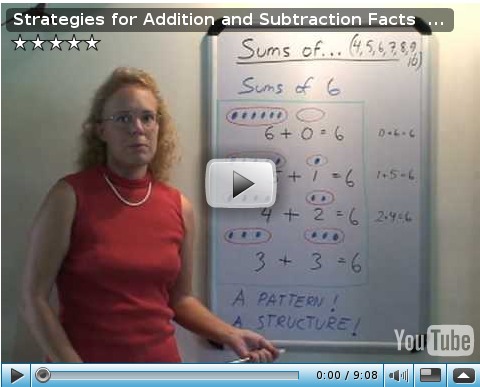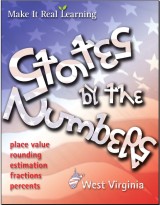Homeschool Math Newsletter, Vol. 33, October 2009
In this month's newsletter:
1. Strategies for basic addition and subtraction facts 1. Strategies for basic addition and subtraction factsIn this video I show several strategies for learning the basic addition and subtraction facts:

Enjoy!
2. Unit studies in math - States by the Numbers
There is a book for each state of the US. Each book has 38 pages (80 activities) Price per book: $2.99 PDF download Free Sample (PDF): North Dakota States by the Numbers is a series of workbooks where the problems in each workbook are based on data from the Census Bureau's 2008 Statistical Abstract of the United States. These workbooks offer a real-data math adventure across the United States! You can use a workbook for your state along with other resources as a unit study about your own state, or your other favorite states. Meanwhile the students will also learn and practice place values, rounding, estimation, fractions and percentages. There are 50 workbooks in the series − one for each state. The price is low; just $2.99 per book. Each workbook includes basic instruction and 80 practice problems. The problems can be used on grades 3-7; probably the best fit is for grades 4-6. Please see this page for more information, including a list of mathematical objectives in each of the books, or see the order page. 3. A review of Giggle FactsGiggle Facts is quite unique. You could call it "a program" to learn basic addition and subtraction facts. But you could also call it a set of math games. Basically, it combines the two: it is a step-by-step progression of math games where at each step, children learn some addition or subtraction STRATEGY (which allows them to learn the facts), or they just practice strategies they have learned thus far.So, these games are not just random "practice your math facts" games. They are designed to be used in succession, in a very specific sequence. In fact, there are 50 different games. The author Laurie Laurendeau says it may take up to a YEAR to go through the complete program with the games. The program (and the games) is divided into 26 levels, from A to Z. There are 15 separate strategies taught within those levels. Some levels simply practice all the strategies learned up to that point. Each level has 1-3 games. Most of the games (33) are board games, and the rest are played with dominoes, dice, playing cards, or pencil & paper. Read the complete review! 4. Understanding basic divisionDenise has made a good post on the concept of division, which I heartily recommend. She deals with a study where Finnish researchers gave this problem to high school students and pre-service teachers:We know that:I really like the question. To solve it, you need to TRULY understand what DIVISION and remainders are all about! Now, let's think about it. Have you ever seen a pattern in division and remainders, like the one below? Continue reading. 5. Tidbits
On October 10, I will be sending out a special message from a sponsor. Other than that... till November, Miss something from the earlier volumes? See newsletter archives. Feel free to forward this issue to a friend. Subscribe here.
| ||||||


